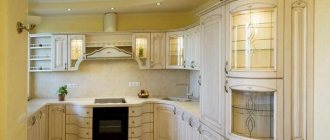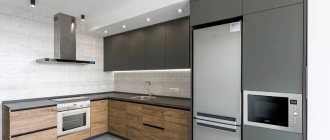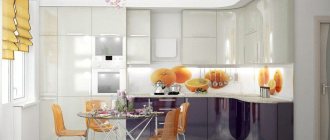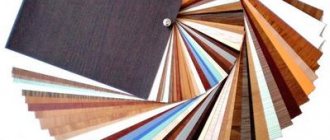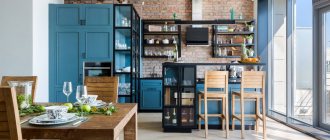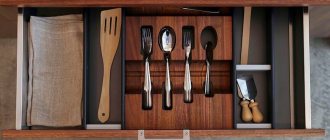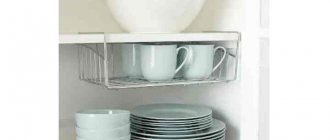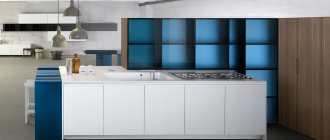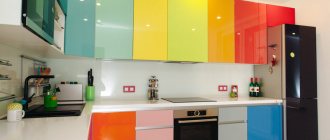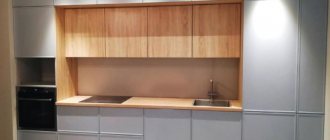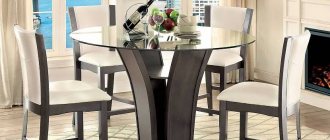Nowadays, the kitchen has become almost the main room in the entire house, second only to the bedroom. The modern pace of life does not leave people a second of free time, therefore, most often, families communicate while sitting in the kitchen, during breakfast, dinner or Sunday family lunches. That is why, when dealing with kitchen decoration and design, it is worth spending a little more time to create the ideal atmosphere, intended both for family evenings and for an exciting time with friends over a cup of tea.
Advantages and disadvantages
Such an original set always attracts more attention than a regular one. Moreover, the smallest imperfections and defects of the room remain unnoticeable: uneven walls, defects in the floor covering and the geometry of the room are smoothed out.
There are many advantages of curved facades:
- beauty and aesthetics. Often, only this factor influences the choice of owners, since it plays a very important role. To many, smooth and oval shapes themselves seem much more attractive than constant right angles;
- reliability ensured by good stability. There is no need for reinforcement or installation of any stiffening ribs, so the manufacturing process is not so difficult;
- safety. The owners will long rejoice at the absence of sharp corners when small children appear;
- increased capacity. If we compare the capacity of the same size standard headset with a radius one, the latter will win;
- increased workplace due to radial protrusions;
- zoning. Concave and convex elements can very successfully divide the space into different functional zones;
- wide range of both design and color;
- Possibility of installation in small and large kitchens.
The disadvantages of radius facades are not so numerous:
- appearance. Still, not everyone likes such extravagant furniture;
- price. The production of bent panels is more complicated, the waste of material is greater, and engineering calculations are more complicated - all this is reflected in the cost;
- deadlines. Such a set is often made to order, which is reflected in the waiting time for furniture;
- if the room does not have a large area, for example, in a Khrushchev-era building, then the set may not look as impressive as planned.
Standard sizes
To avoid discrepancies in the parameters of individual elements, standard sizes were created, which most manufacturers adhere to. Facades can have 4 different radii with individual sizes.
| Radius | Inner radius | Inner chord | Outer chord | Arc length |
| R300 | 2.84 cm | 4 cm | 4.22 cm | 5.15 cm |
| R400 | 3.84 cm | Average value: 5.6 cm | 6.5 cm | |
| R700 | 6,84 | 5.18 cm | 5.3 cm | 4.65 cm |
| R1000 | 9,84 | 7.13 cm | 7.25cm | 7.4 cm |
Standard facade heights are as follows: 536, 573, 716, 956, 1316 mm.
Unique design
Radius facades have a special appearance, giving the room a unique style. Despite the labor-intensive process of manufacturing such structures, such a design will be an ideal option for any kitchen, and their geometric indicators take on different meanings, for example, as in the photo.
The following design is typical for curved facades:
- external, the surface curves outward;
- internal, having a concave base.
Constructions of the second type have a standard radius of 300 mm, and the thickness can be different, ranging from 16–19 mm. Height has constant indicators.
Choice of material and coating
Not just any material can be used to make such a complex structure. For example, solid wood is rarely used, since only certain species are suitable - birch, cedar or beech. Basically, only five options are used for the production of radial facades:
- Multilayer plywood. It is used by craftsmen who make kitchens with their own hands. In this case, the accuracy of all measurements and bending radius plays a critical role. But plywood is an elastic, durable and pliable material, so production can be started even at home.
- Chipboard. Another option that can be used at home is that chipboard bends well, so working with the panels will not be difficult. But the very use of bendable chipboard in the kitchen is questionable, since this material has a loose structure with gaps, which means it is not very dense and may lose its marketable appearance just a few years after installation. Bent laminated chipboard is afraid of moisture and temperature changes.
- Aluminum structures are not the most beautiful option, but they can be used as a frame for the internal filling of the headset. Radial aluminum facades are definitely not afraid of dampness and temperature changes, but they can become deformed and darken during use.
- Steel is suitable for an ultra-modern high-tech kitchen. You just have to take into account that high-tech prefers strict shapes and lines.
- MDF. The most used material because it provides the best results. Finished MDF boards do not bend, so they are bent during production using vacuum pressing. It is this method that guarantees durability and preservation of geometric dimensions.
You can also find individual craftsmen who use not very flexible MDF panels at home, bending them after production - this costs less. But this affects the strength of the material, so the durability of the kitchen is called into question.
Finishing
Due to bending, not every material can be used on radial facades, since not all of them can be bent.
For example, acrylic sheet plastic cannot boast of such a feature, so it is not used. Moreover, the process of fixing the material on a bent surface is quite complicated, especially if you do it yourself.
- PVC film is one of the most popular solutions for kitchen facades, and not only radius ones, but all of them in general. The color range is extensive, and the film itself, if it is of high quality, is not afraid of either moisture or temperature. But if we are talking about poor-quality application or material, then the film may actually begin to come off after some time. It turns out that the most important thing is to monitor quality.
- Coloring — waterproof enamel is used for this purpose. Enameled doors made of MDF or plywood perfectly withstand dampness and contact with water, increased temperature or sunlight. The paint can be damaged, but the damaged area can be easily painted over.
- Veneer is a very thin section of wood several millimeters thick. It bends, so it is easy to use for gluing curved facades even at home. A very important point is to correctly calculate the size of the facade. The veneer will make the doors indistinguishable from natural wood, but at the same time such a bizarre shape that wood cannot have.
- Glass - even radius facades can be glazed. Yes, if we are talking about classic quartz glass, then this option is only made to order. But there is a modern alternative - polycarbonate glass, which bends well and is suitable for DIY work. The main thing is to accurately calculate the dimensions and shape.
Any of these options can give either a glossy or matte finish - depending on the material itself:
- the film can be selected matte, glossy or with a pattern;
- There is also a variety of enamel; you can even layer one layer on top of another to achieve interesting effects, or cover the façade with patina;
- veneer can be coated with varnish - colorless, tinted, matte or glossy;
- It’s the same with glass - it can be transparent or colored, matte or glossy.
Types of finishing for radius facades
- PVC film
Budget level coverage option. The surface is available in a wide range of colors and shades. The advantages of this option include: resistance to moisture, ease of film application, affordable maintenance, and the surface is easily cleaned of dirt. Disadvantages: relatively short service life, the surface can fade, and with constant exposure to high temperatures, the film can peel off over time.
- Painted surfaces
Special enamel forms a reliable, water-resistant coating, making the facades resistant to exposure to moisture. A rounded kitchen in a studio or an ordinary apartment with a painted set offers a wide range of decor options: regular mirror gloss, mother-of-pearl, patterns, metallic effect, neutral and bright colors are available. The enamel is not afraid of high temperatures, aggressive detergents, does not fade under the influence of UV radiation, and minor mechanical damage is easy to repair.
- Veneering
The use of veneer is a harmonious solution for classic styles, ethnic solutions, Scandinavian, minimalist designs. The surface is practically no different from natural solid wood and looks realistic.
- Acrylic
The decorative coating is applied to the MDF panel to create a straight or corner rounded kitchen (photo) using a special adhesive composition and pressure. The result is a uniform, beautiful surface with a wide range of advantages: high strength and resistance to damage, aesthetics of a gloss or matte finish, environmental friendliness, resistance to fading, aggressive substances, and moisture. Over time, acrylic retains its excellent design and technical properties, which explains the growing popularity of this finishing option.
Small rounded kitchens with acrylic coating, thanks to their uniform gloss, visually enlarge the space and visually expand the boundaries.
Radius facades allow the use of glazing, which serves as an additional decoration and facilitates the design.
End processing
If you want to evaluate the quality of a kitchen, then pay attention to its ends. The best option is an ABS edge; it will last a long time and maintain a presentable appearance, despite hot steam, high humidity and even mechanical stress. Moreover, it is more environmentally friendly than PVC edging.
PVC edge is distinguished by its budget cost. It is not a new material on the market, unlike ABS plastic, which is why PVC is very popular. Over time and under the influence of hot steam, this edge may move away, so it is better to keep the kettle away from it. The optimal thickness of such plastic is 2 mm.
If the facade is painted with enamel, then the ends are also painted over - in this case there is simply no need for an additional edge.
Types of radius furniture
The concept of a radius kitchen hides several different solutions at once. They differ from each other not only in the number of radial valves, but also in the features associated with this.
- Rounded corners - in this case, only one or two outer facades have rounded outlines. Not even a radius kitchen cabinet is used as a wall unit, but simply semicircular shelves. Most often this is modular furniture, where only the outer sections occupy a stationary position. The shape does not affect the area of the space in any way, but the kitchen looks more ergonomic due to the absence of sharp corners.
- Separate radius facades — in addition to bent ones, they also make several central facades. This is no longer modular furniture, since the composition itself is built from a combination of convex and flat facades. This solution is impressive, but takes up a little more space than usual.
- Only curved facades - here there is already a combination of concave and convex elements. It is very difficult to make such a set with your own hands, so the furniture is made to order. The result will be an unusually impressive set. Especially if the facades are glossy and bright in color. But you need to understand that such a kitchen will take up more space than standard units.
- Curved set - this is already a fantasy on the theme of Antonio Gaudi, where not only the facades are bent, but also the furniture. The most spectacular solutions are with a bar counter or island. From a practical point of view, this is a very convenient ensemble, but it takes up a lot of space.
Facade bend
Not only can curved furniture itself be of different types, but also the facades themselves can have different curves:
- standard - convex, with a cross-section in the form of an oval arc or circle;
- wavy - the wave on facades can be either vertical or horizontal. The first option is used for wall cabinets;
- with an asymmetrical radius - a very impressive, but also incredibly difficult solution to manufacture;
- concave - the opposite option to the standard one.
The bending radius itself depends on the capabilities of the material and its correct processing. Curved facades will fit into almost any interior, but you should still choose the shape carefully:
- it should not reduce kitchen space;
- must be in harmony with the design.
Mixed furniture shapes
Sometimes a corner round kitchen is not suitable for the area and layout of the house or has only a rounded facade. But if the organization of space allows for the placement of round furniture in the center of the room, then you should buy a round table for the kitchen. Semicircular, round or oval shapes are always more practical than rectangular ones of the same size.
A table that does not have corners can accommodate more people and can accommodate more cutlery. In addition, everyone will see each other and communication will cause less inconvenience. It is also convenient that the round table has no edges and you can leave it without disturbing those sitting next to you.
Facade design options
In addition to the shape of the facade, it is also necessary to decide on its appearance. In this case, it is better to proceed from the general style of the house and kitchen, in particular. There are several options for how to decorate a radius façade.
- Color. If you choose painting or film coating, you can create almost any color that comes to mind. It is advisable not to choose too dark shades, as they are easily soiled and can visually reduce the space. Moreover, the more complex and curvy the design of the headset, the lighter its tone should be, so as not to overload the space.
- Photo printing. This idea seems dubious to designers, since the image will be printed on radius facades, which means its perception will be disrupted. If you choose some kind of print, it should be abstract drawings and patterns, and not photos of fruits, coffee or the like.
- Milling. The possibility of milling depends on the material used as the basis of the facade. Some companies are ready to mill MDF radius doors. This embossed option is best suited for kitchens in the style of classic, country, Provence and the like.
- Glass will make the kitchen more sophisticated and original. It is best to choose a material with a thickness of 4 to 10 mm. There are both matte and glossy surfaces, as well as glass with curly processed edges.
Arrangement of kitchen facades
Depending on the external design of the doors and their aesthetic role, these parameters depend on several points:
- Design features are determined by classic and radius shapes.
- The raw materials used affect the service life and operating conditions of the product.
- The basis of the base surface. Some types of doors have a natural finish, however, economy class models require the use of inexpensive materials: plastic, veneer, film.
- Application of decorative elements: glazing, milling, photo application.
Selection of accessories
The construction market now offers a huge range of fittings for radius fittings, including hinges. From a technical point of view, hinges can be divided into those with and without a closer. A closer is a special mechanism with which doors close smoothly and door slams are eliminated.
There are also loops for:
- overhead doors - they cover the ends of the side walls of the frame;
- adjacent doors - when used, the facade covers the edge of the side of the cabinet by half;
- inset doors - used when the depth of the door does not protrude beyond the cabinet frame.
For corner cabinets, you should take a closer look at crab hinges. The best fittings are made by German.
What styles are appropriate?
According to the designers, the radius set can fit into any room from baroque to modern style. You need to focus on the facade itself: its color, decor, finishing, and so on. For example,
- The classic style will be characterized by a coating of light matte enamel, as well as sophisticated milling. Perhaps the owners will even emphasize it with patina. Radius glass will also be in place;
- in a country style, a radius set will look appropriate, but there should be less decor, since the design initially assumes rustic comfort;
- in a modern style, you can use your imagination to the fullest and create a simply unique interior element with a riot of colors, shapes and patterns.
General style elements
If the choice, when decorating a kitchen space, falls on ultra-modern technological styles, close to modern or high-tech, then a radius set is more suitable for this than others. In unique designs, it becomes possible to use the latest technical and design discoveries, as well as the most unusual materials and objects.
Additional furnishing details include chandeliers, lamps, household appliances, decorative ornaments, dishes and even a round kitchen hood. When everything is chosen tastefully and harmoniously complements each other, this is a good basis for establishing peace and joy for the inhabitants of the living space.
Layout options
Designers claim that rounded facades are not just an original solution, but also a universal solution in terms of placement. They will fit perfectly into the interior of a combined kitchen-living room or studio, but will look no less impressive in an ordinary standard kitchen. There are several of the most popular radius kitchen layouts that highlight all the advantages of such an unusual set.
- Straight is the most common layout that can be: furniture is placed along one wall. Differs in versatility. The best solution for this layout would be to round off the end cabinets with a curved facade, for example, if they interfere with the passage.
- Corner - in this case, the corner itself is smoothed out and a sink is built in there. Washing dishes with such a set is a pleasure. At the same time, more free space appears in the cabinet under the sink, where you can arrange additional storage (for example, a “magic corner”).
- With an island - a very functional solution that is suitable only for a large kitchen. It is advisable to make the island radius, that is, without corners - this way the room will look as harmonious as possible. This decision will be especially appreciated in those moments when small children appear. In addition, this will help, at least a little, to widen the passage and make it safer.
Selection of curved facades
Experts give several recommendations with which you can choose the ideal headset for your needs:
- a radius set is truly unique furniture, so it requires adjustment not only to the style of the room, but also to its size;
- if the kitchen is small, then you should abandon “multi-wave” facades, so as not to visually reduce the space - it is better to opt for a set with one or two waves;
- it is best to choose a bent set made of plywood or MDF - this is the optimal solution in terms of price/quality;
- the more complex the design, the more neutral the color.
How to do it yourself?
If you wanted, you could make anything with your own hands, even radius facades. But in this case, desire alone is not enough; it is necessary:
- be able to make accurate measurements;
- special equipment;
- be able to find curved cornices and false panels - they are rare and expensive.
Even making such furniture with your own hands will cost more than regular furniture.
Design
The easiest way is to contact a specialist who will carefully and accurately collect all measurements, from which you can then find all the necessary components in the catalog. If you definitely decide to make curved facades yourself, then you must follow some principles:
- the round corners of the kitchen facades, which are located on top of each other, must have the same radius;
- it is advisable to adhere to the rule of symmetry;
- You cannot make shelves and facades of the same set of different radii.
The calculation itself is not very complicated: the point is that any radius horizontal element (shelf, tabletop) is divided into two parts - with a straight side and a curved one. The curved one represents a quarter of a circle.
Making a template
The template greatly saves the time of cutting the following elements, and at the same time serves as a guarantee that there will be no errors in the manufacture of identical elements, for example, shelves.
To begin with, the template is made from cardboard, and then transferred to a chipboard or MDF board, which must be bent. When cutting, it is used as a sample.
Creating a template for a curved facade is more difficult. Typically, a metal blank with the required radius serves as a sample. But any other material that can withstand pressure will do, even durable plastic.
Facade production
After calculating all the required dimensions and transferring them to the material, a workpiece is cut out. It is very important to trim the edges correctly so that after the slab is bent, the ends of the facades touch at right angles.
- To achieve a bend, it is necessary to make cuts on the back side. It is necessary to carefully approach the issue of the location of the cuts, because if they are too frequent, the semicircular door will crack; if they are too far, ribs will appear on the facade.
- Typically, the depth of the cut is three quarters of the thickness of the facade, and the pitch is up to 3–5 cm. The cut itself should not be more than 4 mm wide; you need to select a suitable blade. The incision is not made along the entire length of the facade - 7–10 cm should be left along the perimeter.
- After this, it is necessary to make a protective layer for the facade; for this, smooth fiberboard is used. It must be glued to two layers of PVC.
- The workpiece is secured with tightening straps to the blank. You must wait until the glue is completely dry.
- Then the ends are covered with an edge. It is difficult to do this on a facade of an unusual shape, so it is better to use an edge banding machine.
- The next step is finishing in any way you like - pasting with film, painting, veneering, and so on.
Using the same technology, a radius base is also made, if necessary.
How to integrate equipment?
After the facades are made, it’s time to attach them to the frame and build in the equipment. It is at this point that many people have problems, because integrating equipment into a convex or wavy façade simply won’t work. In this case, there are only two options:
- do not integrate equipment at all;
- embedding it in another place, for example, in a tall cabinet-column - this solution is considered the most modern, optimal and convenient.
An interesting option: the entire kitchen without corners
An ideal solution for a kitchen where there are small children. There will be no more abrasions on the head and drops of Valocordin in the glass!
Not only does the absence of sharp corners in the kitchen make work more productive and simpler, it also saves people. Not only the little ones, but also the owners themselves, since no, no, but also adults hit the corners of the headset. Of course, the most painful thing is the little finger.
In this case, we mean not just kitchen sets without sharp corners, but also:
- bar counter;
- island;
- table;
- and even stools!
Of course, the very top is to remove the door and make a rounded wall, if there is one at all.
Complement this safety idea with better designed handles. Perhaps it will be a push-to-open kitchen system without handles, integrated handles that represent a profile on top of the facade, or some other option. The main thing is that they cannot be hit or scratched too much, that is, it is better to give preference to plastic options rather than metal ones.
Advantages of a kitchen with rounded facades
- Aesthetics: smooth lines bring harmony and balance to the interior. This set looks more delicate than strict angular facades with square and rectangular elements.
- Minimum injury: the main culprits for bruises at home are corners. Rounded kitchens (photo) are completely safe due to their design features.
- Reliability and strength: the presence of additional stiffening ribs ensures the structure’s resistance to loads and mechanical damage. The materials used have the necessary properties to form convex and concave elements.
- Rounded shapes fit perfectly into a small room or an irregularly shaped kitchen.
- The design of a rounded kitchen suggests the possibility of zoning the space with elements with smooth shapes, for example, a special bar counter.
- Ergonomics: curved shapes ensure easy placement of all necessary items. Achieving this level of comfort with rectangular shapes is more difficult.
What is Feng Shui?
Smooth curves of furniture are always beautiful and non-trivial. But besides this, according to the teachings of Feng Shui, curved shapes will bring peace of mind, tranquility, harmony in relationships and even an influx into the family budget to the apartment.
And all this because, according to Feng Shui, it is in the corners that negative energy accumulates, which can harm the owners of the apartment.
You can believe in it, you can not believe it, in any case, this is a good bonus to a beautiful kitchen.
Kitchens with curved facades
Suitable style for small space
Even convinced supporters of classic straight lines in the design of home premises, after seeing a photo of a round kitchen with its smooth lines and lack of corners, can change their tastes.
Softness and roundness of shapes always creates more comfort and peace in any living space. And the flow of lines into each other contributes to the dynamics and harmony of the surrounding environment.
The purpose of the kitchen for preparing food and communicating with the whole family over meals makes it a special room in the house, which should be rationally equipped for convenient and quick cooking.
At the same time, its style, different from other rooms, should be original and relaxing for communication between loved ones in a home environment. No wonder round dining tables for the kitchen have always been a symbol of reconciliation and friendly conversation.
